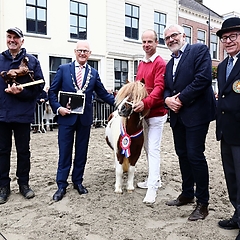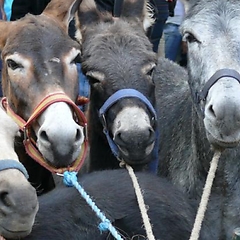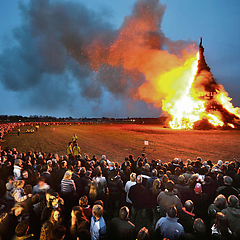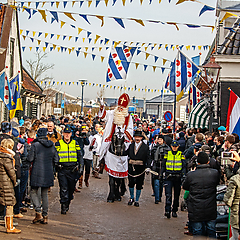The corso season start with brainstorm sessions with designers. The best ideas are elaborated and in spring every parade group chooses one design. In big tents the frames are welded together. During the summer market in July the participating groups present their designs. The welded shapes are covered with papier-mâché and painted in the right colours. During the last days before the parade the dahlias are stuck on the floats and secured. And then the time has come: the second Sunday of September, the day that all the floats are shown to the public and also: the beginning of the fair. In the morning the floats are judged by a professional jury, consisting of float-builders from other parades in the Netherlands, along with (flower)arrangers and designers. Early in the afternoon the floats move through the streets of Lichtenvoorde, with the Children’s Parade up front. In between the floats music bands and street theatre groups give their performances. After the parade the floats are displayed on a site where everyone can quietly admire them. The day is festively closed off in various bars and restaurants. On Monday the prizes are awarded. Afterwards the fair is open again, the annual wooden bird shooting takes place and there is a lot of dancing and celebration. Tuesday is the last day of the parade joy of that year and the festival ends with fireworks.
Description
Community
The Lichtenvoorde Flower Parade is a social-cultural event that bonds the community of all levels. It is a symbol for the pride and passion of many generations. The event is organised by the Stichting Bloemencorso Lichtenvoorde (Lichtenvoorde Flower Parade Foundation), which also takes care of promotion. The floats are built by the eighteen existing parade groups. To engage young children, they have got their own department within the parade, the Parade KIDS.
History
In the first few years the parade did not go through the streets each year and small carts, wheelbarrows and bikes were decorated, mainly with grass and heath and sometimes a few flowers. As of 1926 it became an annual recurring flower parade, meant as accompaniment of the wooden bird for the Kings’ shooting, the highlight of the fair. The celebration around the liberation and the millennial feast of Lichtenvoorde in 1946, must have provoked a sense of togetherness among the inhabitants. Neighbourhood associations started to participate in the parade. In 1957 it was decided that the floats had to be decorated with dahlias, as much as possible. The size of the floats increased and by the end of the sixties there were participating floats with more than 20,000 flowers. The eighties were characterised by record numbers of participants and visitors. Showbands and street theatre groups were added to the parade and some 50,000 people came to watch. The number of flowers on the floats rose considerably. Between 1990 and today the flower parade has developed from a static parade to a dynamic one. Bit-players on the floats play a role in depicting the subject and the floats themselves have more and more moving parts. These adaptations and innovations ensure the lasting attraction of the event.
Safeguarding
2024-2026
- The relocation and refurbishment of the VVV offers opportunities to raise the profile of the flowerparade in a permanent location. The idea is to permanently equip a significant part of the VVV for the benefit of the flowerparade.
- The ongoing projects CorsoWijs, corsoles, Corsokriebels will be continued.
- The possibilities of realising a Corso Skills Lab under the current circumstances (politics, economic climate) will be investigated.
- The physical archive will be moved to the Achterhoek Liemers Heritage Centre.
- A digital archive will be set up for the purpose of making documents/photos accessible.
- The search for ways to positively promote the flowerparade to the outside world continues.
- Together with the flowerparade groups, instruments will be set up to stimulate the recruitment of young/new builders.
- When a new building site is put into use, an analysis is immediately carried out for a subsequent (third) building site.
2017-2019
- Having conversations with insurance companies in order to get the best price and quality conditions. Collaborate with other corso towns.
- Paying extra attention to safety within the relevant working groups (parade, technique and safety).
- The corso groups give the young designers plenty of opportunity to come up with designs. Offering (or continuing to offer) welding courses for young people in order to involve them in building.
- Composing a teaching programme for primary schools in which all aspects of the parade are addressed. For this purpose teaching programmes of carnival groups from the south of the Netherlands are used as an example.
- Older welders will make undercarriages for about 10 small cars for participants of Corsokids. These will be stored in their own garages. In these garages children starting in Corsokids can also decorate their small trolleys and bicycles with flowers.
- Following in the footsteps of the six Syrian asylum seekers with residence status who are now helping corso groups, this number will be increased. In this way, the parade tries to increase social responsibility and to build a broader support base.
2013-2015
- There have been many conversations with the municipality. All corsos groups now have a construction site, a tolerance policy has been established for all existing construction sites and the zoning plan for the outlying area has been adjusted. The municipality recognizes the importance of the parade for the community.
- An own location has been acquired where participants of Corsokids can decorate their trolleys and park them. For this purpose, funding has been obtained from external sponsors.
- Extra attention has been paid to safety: adaptation of the parade regulations, stricter checks and advice on the floats, checking and writing safety plans for the construction sites, coordination with the municipality and the police on traffic plans, good management at the parade coordination point and continuous improvement of the instruction of the supervisors of the parade floats.
- Primary school pupils are involved in the parade by: newsletters, postcards, the children's games, by mascot Dahleo, local newspapers, visits to the participating CorsoKIDS, information meetings, Corsokriebels (design talents).
- The parade has been successfully promoted in Germany. There are many German visitors and contacts have been made with German parades.
- The recommendations in the thesis were implemented: more German visitors, use of social media, a promotional caravan for sponsors, better information provision.
- People with disabilities are involved in the parade through the Corsotuin project.
- Asylum seekers with a residence status are involved in the corsos groups. This commitment is appreciated by both the municipality and sponsors.
- By offering welding courses for young people, they are actively involved in the intangible heritage.
- A policy memorandum has been written to draw up a teaching programme.
Contact
Stichting Bloemencorso LichtenvoordeHet Brook 23
7132 EH
Lichtenvoorde
Website



